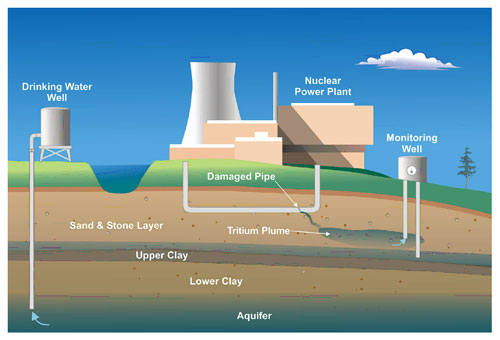Backgrounder on Underground Pipes at Nuclear Reactors
On this page:
Background
 In the past, minor corrosion caused leaks in underground or buried pipes and related systems at several U.S. nuclear power plants, contaminating groundwater with minor levels of radioactive material. The plants’ safety systems still function properly despite these leaks. The types and amounts of radioactive material involved in the leaks fall short of the limits the NRC sets to maintain public health and safety, so the leaks do not present a risk to the public.
In the past, minor corrosion caused leaks in underground or buried pipes and related systems at several U.S. nuclear power plants, contaminating groundwater with minor levels of radioactive material. The plants’ safety systems still function properly despite these leaks. The types and amounts of radioactive material involved in the leaks fall short of the limits the NRC sets to maintain public health and safety, so the leaks do not present a risk to the public.
The most recent buried pipe leaks have mainly involved water with above-normal levels of tritium, a mildly radioactive isotope of hydrogen normally measured in picocuries (trillionths of a curie) per liter. The NRC reviews affected plants’ groundwater monitoring programs to confirm the leaks do not affect public health and safety and the environment. The NRC’s oversight of the buried pipe issue as a whole focuses on ensuring nuclear power plant operators properly monitor and, when necessary, repair the pipes.
NRC Response
The NRC’s regulations focus on systems necessary to safely operate the plant or safely shut it down in case of an emergency. These safety systems’ buried piping is subject to inspection and testing requirements laid out in agency regulations and standards from the American Society of Mechanical Engineers. These standards call for regular flow testing and other examination of buried safety-related pipes, and NRC reviews have confirmed nuclear plants perform these tests several times every year. If leaks are detected, they must be repaired, although the repairs can be postponed up to 24 months if circumstances permit. NRC regulations also require plants to ensure procedures and resources are in place to prevent potential leaks from exceeding limits on radioactive material releases and public radiation doses. The agency’s resident inspectors, who are stationed full time at U.S. nuclear power plants, regularly monitor all these activities. Any deficiencies can trigger additional NRC oversight of buried piping issues.
Industry Response
When a nuclear plant licensee wants to renew a plant’s operating license, the licensee must show it can account for the effects of aging on a plant’s systems. Some categories of buried piping fall under these requirements. The NRC judges a plant’s Aging Management Programs against examples in the agency’s Generic Aging Lessons Learned report, which includes information on the aging of buried pipes’ interior and exterior surfaces. License renewal applications include, where appropriate, terms for additional buried pipe inspections and replacement programs to account for recent operating plant experience. The NRC revised the GALL report in 2016, and issued a similar report in 2017 for plants seeking a second renewal. These updates incorporated new information on managing buried piping. The agency also issued revised guidance for staff conducting license renewal inspections and reviews.
License Renewal
Applications for new nuclear power plants must show that the proposed reactor meets the same buried piping requirements current plants follow. The nuclear power industry and NRC staff are working with ASME to develop design requirements that use alternative materials to ensure stronger, more long-lived buried piping. Applicants for design certifications and new reactor licenses must also describe how their designs and operational procedures will ease eventual decommissioning by minimizing any contamination of the facility and environment, as well as the creation of radioactive waste. The NRC staff will incorporate current operating reactor experience as they review and evaluate measures applied by new reactor applicants to confirm they will minimize contamination. To date, many applications describe using fewer buried piping systems for fluids contaminated with radioactive material.
New Reactors
Applications for new nuclear power plants must show that the proposed reactor meets the same buried piping requirements current plants follow. The nuclear power industry and NRC staff are working with ASME to develop design requirements that use alternative materials to ensure stronger, more long-lived buried piping. Applicants for design certifications and new reactor licenses must also describe how their designs and operational procedures will ease eventual decommissioning by minimizing any contamination of the facility and environment, as well as the creation of radioactive waste. The NRC staff will incorporate current operating reactor experience as they review and evaluate measures applied by new reactor applicants to confirm they will minimize contamination. To date, many applications describe using fewer buried piping systems for fluids contaminated with radioactive material.
More information on buried piping, including links to industry and NRC guidance, is available on the NRC website.
December 2024
Page Last Reviewed/Updated Tuesday, December 10, 2024
Page Last Reviewed/Updated Tuesday, December 10, 2024

